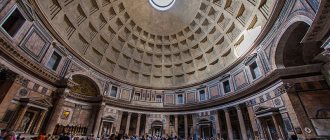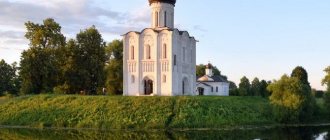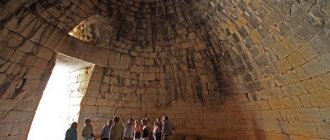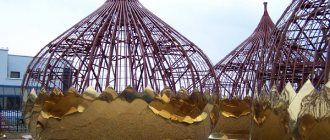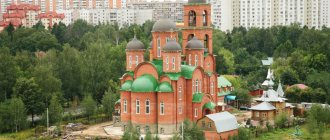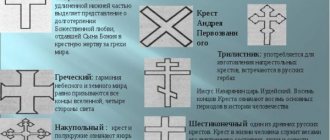"Save me, God!".
Thank you for visiting our website, before you start studying the information, please subscribe to our Orthodox community on Instagram, Lord, Save and Preserve † - https://www.instagram.com/spasi.gospodi/. The community has more than 60,000 subscribers. There are many of us like-minded people and we are growing quickly, we post prayers, sayings of saints, prayer requests, and timely post useful information about holidays and Orthodox events... Subscribe. Guardian Angel to you!
The color of the domes of Orthodox churches has symbolic meaning and spiritual value. The same applies to the wall paintings of temples. This is not only an expression of an artistic idea, but also a connection between the coloring and other designs and the person to whom the building is dedicated. So, you can find out what the color of domes depends on and what they are like from our article.
The importance of temples in people's lives
Each nationality has its own faith and the necessary buildings - a church, a temple, a mosque. In such buildings, a person offers a prayer to the Lord about his sins, repents, prays for loved ones, and is in a state of mental peace. Any such building has a vault, which is made of the best materials and has an attractive color.
The meaning of the colors of the domes of temples in any religion has a symbolic definition. We can say that the vault is the main decoration of the temple and its shape resembles a parabola or hemisphere.
The founders of domes were the Romans. They used concrete to build wonderful structures that covered large buildings. The oldest vault is in the Roman Pantheon, built around 128.
The very first city in Rus' to receive baptism was Kyiv. The ambassadors of Prince Vladimir were amazed by the beauty of the Cathedral of Sophia in Constantinople. This is what served as the basis for Russian architecture in the construction of churches. Masters built churches in Rus' in the traditions of Byzantine architecture with domes.
The best article for you, go to: What is the grace of God and how does it work
Dome shapes
In addition to its immediate purpose as an architectural structure, a temple means something more in the Orthodox faith. The temple is a reflection of heaven on earth, man and the ark.
The shape of the dome can be different: oval and bulbous, sailing and umbrella, saucer and tent, the Byzantine-Russian version. And so, the forms:
- The oval vault resembles an egg and originates from the Baroque style.
- The umbrella has elements that go from the center to the base.
- The helmet shape suggests that the church is constantly fighting evil and darkness.
- The most popular shape is bulbous, which means the candle sign is the light of the world.
The bizarre appearance of the vault and coloring testify to the beauty of Heavenly Jerusalem.
In the wall paintings of cathedrals, the following shades are most often used: red, white, green, blue, yellow. Color meaning:
- White coloring is a sign of clarity and transparency, mainly in churches in honor of the Transfiguration and Ascension.
- Red color is intended for the churches of the great martyrs.
- The blue coloring is dedicated to the cathedrals of the Virgin Mary and signifies chastity and innocence.
- If the temple was erected to honor the monk, then more green is present, as a sign of renewal.
- The yellow color of the sun is to honor the saint.
The best article for you, go to: The largest Orthodox church in the world, Russia, Europe
Russian temple buildings have a peculiarity - they are multi-domed. It is generally accepted that if a church has several domes, then it is of Russian origin. But a distinctive feature of Russian cathedrals is their coloring.
Blue domes with gold stars
These blue and gold St. Petersburg domes managed to survive the elements, years of neglect, and a major fire.
One of the most beautiful and certainly the brightest cathedral of St. Petersburg is located in the Admiralteysky district just across the Fontanka River. The Cathedral of the Holy Life-Giving Trinity of the Life Guards Izmailovsky Regiment - this is the full name of the cathedral - is often called Trinity or Trinity-Izmailovsky. Its history began in 1827, when Nicholas I decided to build a stone cathedral in St. Petersburg for soldiers and officers of the Life Guards Izmailovsky Regiment. The stone cathedral had predecessors: a camp summer tent church with a folding iconostasis, and then a wooden church. The Izmailovsky Regiment, formed in the village of Izmailovo near Moscow, was stationed in St. Petersburg among swampy forests on the banks of the Fontanka since 1731. In this place, a regimental settlement was built, which was formed along the current Izmailovsky Avenue. Streets for 12 companies, which were called: 1st Company, 2nd Company, etc., ran perpendicularly from it. (today these are Krasnoarmeyskie streets). The architectural appearance of the military town of the Izmailovsky Regiment was completed with the building of a new stone church, built to replace the dilapidated wooden church. The snow-white, airy Cathedral of the Holy Life-Giving Trinity was built according to the design of the architect Vasily Stasov. Although the temple was built for the imperial regiment and was the main garrison church, among its parishioners there were many famous civilians: Ivan Krylov, Gabriel Derzhavin, Fyodor Dostoevsky, Sergei Prokofiev. Alexander Sergeevich Pushkin came to the cathedral for the wedding of his older sister Olga.
The magnificent monumental temple - the decoration of St. Petersburg - can accommodate more than 3,000 people (at the time of consecration in 1835, almost the entire Izmailovsky regiment could fit inside). Trinity Cathedral has a height of 86 meters and is the fourth architectural dominant of the city center: immediately after the Peter and Paul (122.5 m), St. Isaac's (101.5 m) and Smolny (93.7 m) cathedrals. In its size, the Trinity Church is second only to St. Isaac's Cathedral. The blue and gold domes of the Holy Trinity Izmailovo Cathedral are easily recognizable in the skyline of the Northern capital. But they were repeatedly on the verge of complete destruction. The first problems arose already at the stage of construction of the central drum with a dome. In August 1830, 16 columns on which the dome rested could not withstand the load and cracked. Strengthening the stability of the main dome continued for more than a year.
By the end of 1832, the scaffolding was removed from the roof, the main dome was decorated with 280 gilded stars, and it appeared in all its glory. But now the elements intervened: three months later, a storm that raged not only over St. Petersburg, but throughout Europe on the night of February 23, 1833, tore off the main dome and damaged one of the domes. Studying the reasons for the incident, the commission came to the conclusion that the structure was too heavy and its iron ribs were insufficiently rigid. The creation of a new dome project was entrusted to civil engineer Peter Bazin. He abandoned iron and came up with a wooden radial truss design, unique for a dome of this size.
Built to last, the temple was severely damaged by artillery shelling during the Great Patriotic War: bombs damaged the domes and the western façade. When the cathedral was returned to believers in 1990, it was in a deplorable state: the basements were flooded, the windows were collapsed, and rain and snow got inside through holes in the dome. In 1996, lengthy restoration work began, but 10 years later the temple was again subjected to severe testing. This time the element was fire. On August 25, 2006, a terrible fire occurred: the scaffolding of the central and northern domes caught fire, and the fire spread to the attic. Several dozen fire crews and a helicopter spent five hours extinguishing the flames, but it was not possible to save the dome. The 50-meter ladders did not reach the top, and the fire hoses were not long enough. The central wooden dome, which had served for 170 years, burned completely.
After the fire, fundraising began for the restoration of the temple. Donations were made by city residents, rectors of St. Petersburg churches and organizations. 3 million rubles were donated by His Holiness Patriarch Alexy II, 10 thousand euros were allocated by the Pope. It took 10 years to eliminate the consequences of the fire, 5 of them to restore the dome. The Hermitage kept the drawings and model of the dome of the engineer Bazin, but experts decided not to use the truss structure he developed. Instead, a frame of 32 wooden semi-arches weighing 2.5 tons each was installed. The frame elements were mounted on the ground and lifted onto the drum using a tower crane. The domes were covered with copper, and hexagonal stars were recreated on them. At one time, Nicholas I chose this symbol to decorate the domes as a truly military symbol. The restoration of the Trinity Church lasted a total of 21 years and was completed only in the spring of 2022. The restored Trinity Cathedral is literally filled with light. Laconic decoration with an abundance of white, five light drums and a newly made grandiose central chandelier: a chandelier 9 meters high, lost 80 years ago.
If you are in St. Petersburg, be sure to come to the Trinity Cathedral. Admire the beautiful temple, recreated in its historical form, the work of icon painters and artists, remember the glorious exploits of the Izmailovsky regiment and worship the great Orthodox shrines. A particularly revered relic of the Holy Trinity Izmailovo Cathedral is the icon of the Holy Life-Giving Trinity, which is over 600 years old. This is the oldest icon that is in St. Petersburg Orthodox churches. It was painted by a master of the Novgorod school around 1406. After the revolution, the authorities confiscated the icon along with other valuables. The holy image was placed in the Tretyakov Gallery and then sold to a private American collection. The icon was exhibited at many exhibitions, and in the early 2000s it was bought by Russia at Christie's auction. In 2003, during the celebration of the 300th anniversary of St. Petersburg, Vladimir Putin donated the icon to the Holy Trinity Izmailovsky Cathedral. In the Trinity Cathedral, as in every Orthodox church in the Northern capital, there is an icon of St. Blessed Xenia of St. Petersburg. However, the icon of the Holy Trinity Izmailovo Cathedral is unique; it is the first image painted from the lifetime portrait of Xenia, which is kept in the storerooms of the Hermitage. In the icon, Blessed Xenia of St. Petersburg - the heavenly patroness of St. Petersburg - looks as she was in life.
The history of the long-suffering Holy Trinity Izmailovo Cathedral continues. Blue domes once again decorate the city on the Neva, relying on the mercy and will of God. St. Petersburg, Izmailovsky Prospekt, 7a.
The meaning of the colors of the domes of Orthodox churches
What do the colors of church domes mean in Russia? The color of the vault depends on who the building is dedicated to.
The meaning of the color of the gilded dome is a sign of heavenly glory. Gilded vaults exist only in the Orthodox denomination. Gold for Russian Orthodox people is a sign of incorruptibility, immortality, greatness, the idea of ardor and combustion.
The blue vaults, decorated with stars, are dedicated to the Virgin Mary. The decorations are reminiscent of the Star of Bethlehem in honor of the birth of Christ by the Virgin Mary.
Vaults dedicated to the Holy Trinity or some other Saint are painted green. This is also the color of the Holy Spirit. May also be gray or silver in color.
The black color of the domes means that such buildings have monasteries.
The meaning of dome flowers
Regardless of what kind of painting is used to paint the ceiling vaults, it tells people about the beauty of Heavenly Jerusalem. Most often you can see holy places with golden-colored domes, which speaks to believers about incorruptibility, immortality, and majesty. The golden vault symbolizes heavenly glory. Blue domed buildings decorated with stars are also not uncommon in Russia - this indicates the dedication of the temple to the Mother of God. Additional decorative elements serve as a reference to the Star of Bethlehem, which tells about the coming of the son of God to earth. Green shades are considered the colors of the Holy Trinity and other saints. And the black tint of the domes indicates that the temple belongs to the monastery territory.
The value of the number of domes of the temple
Cathedrals also differ not only in color, but also in the number of vaults. Orthodox cathedrals are built with an odd number of chapters. The number of domes corresponds to the construction of the heavenly church:
- 1 - dome is a sign of God;
- 2 - these are the two natures of an angel and a person;
- 3 is the Holy Trinity;
- 4 - means four cardinal directions;
- 5 - serves as a symbol of Christ and the four evangelists;
- 7 - sign of the seven sacraments, Ecumenical Councils and virtues;
- 9 are the nine ranks of angels;
- 13 - Jesus Christ and the twelve apostles;
- 25 - means praise to the Virgin Mary;
- 33 is the number of years of Christ’s life on earth.
The best article for you, go to: How to deal with the mortal sin of despondency, the Orthodox answer
The meaning of the color may not depend on the purpose of the cathedral. Coverage depends more on material resources and climatic conditions than on existing regulations. For example, the Church of the Holy Trinity in Antarctica does not have a green vault. It is made of natural wood, because this material does not rot in extremely low temperatures and has a natural color.
An interesting and surprising fact is that the shape of radar domes and bowls is calculated using the same formulas. It can be assumed that the vault is a catcher of unknown radiation from the Universe. Any spire and dome plays the role of a lightning rod during a thunderstorm.
The Lord is always with you!
